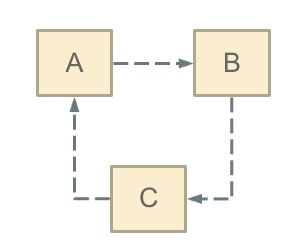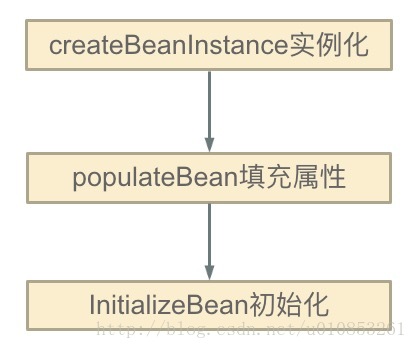一. 什么是循环依赖?
循环依赖其实就是循环引用,也就是两个或者两个以上的bean互相持有对方,最终形成闭环。比如A依赖于B,B依赖于C,C又依赖于A。如下图:

注意,这里不是函数的循环调用,是对象的相互依赖关系。循环调用其实就是一个死循环,除非有终结条件。
Spring中循环依赖场景有:
(1)构造器的循环依赖
(2)field属性的循环依赖
其中,构造器的循环依赖问题无法解决,只能拋出BeanCurrentlyInCreationException异常,在解决属性循环依赖时,spring采用的是提前暴露对象的方法。
二. 怎么检测是否存在循环依赖
检测循环依赖相对比较容易,Bean在创建的时候可以给该Bean打标,如果递归调用回来发现正在创建中的话,即说明了循环依赖了。
三、三种循环依赖
1:构造器的循环依赖。【这个Spring解决不了】
Spring容器会将每一个正在创建的Bean 标识符放在一个“当前创建Bean池”中,Bean标识符在创建过程中将一直保持在这个池中,因此如果在创建Bean过程中发现自己已经在“当前创建Bean池”里时将抛出BeanCurrentlyInCreationException异常表示循环依赖;而对于创建完毕的Bean将从“当前创建Bean池”中清除掉。
Spring容器先创建单例A,A依赖B,然后将A放在“当前创建Bean池”中,此时创建B,B依赖C ,然后将B放在“当前创建Bean池”中,此时创建C,C又依赖A, 但是,此时A已经在池中,所以会报错,因为在池中的Bean都是未初始化完的,所以会依赖错误 ,(初始化完的Bean会从池中移除)
public class StudentA { private StudentB studentB ; public void setStudentB(StudentB studentB) { this.studentB = studentB; } public StudentA() { } public StudentA(StudentB studentB) { this.studentB = studentB; } }
public class StudentB { private StudentC studentC ; public void setStudentC(StudentC studentC) { this.studentC = studentC; } public StudentB() { } public StudentB(StudentC studentC) { this.studentC = studentC; } }
public class StudentC { private StudentA studentA ; public void setStudentA(StudentA studentA) { this.studentA = studentA; } public StudentC() { } public StudentC(StudentA studentA) { this.studentA = studentA; } }
上面是很基本的3个类,,StudentA有参构造是StudentB。StudentB的有参构造是StudentC,StudentC的有参构造是StudentA ,这样就产生了一个循环依赖的情况,
我们都把这三个Bean交给Spring管理,并用有参构造实例化
<bean id="a" class="com.liuqing.student.StudentA"> <constructor-arg index="0" ref="b"></constructor-arg> </bean> <bean id="b" class="com.liuqing.student.StudentB"> <constructor-arg index="0" ref="c"></constructor-arg> </bean> <bean id="c" class="com.liuqing.student.StudentC"> <constructor-arg index="0" ref="a"></constructor-arg> </bean>
下面是测试类:
public class Test { public static void main(String[] args) { ApplicationContext context = new ClassPathXmlApplicationContext("com/liuqing/student/applicationContext.xml"); //System.out.println(context.getBean("a", StudentA.class)); } }
执行结果报错信息为:
Caused by: org.springframework.beans.factory.BeanCurrentlyInCreationException:
Error creating bean with name 'a': Requested bean is currently in creation: Is there an unresolvable circular reference?
2、setter方式单例,默认方式
Spring中Bean实例化的图
如图中前两步骤得知:Spring是先将Bean对象实例化【依赖无参构造函数】--->再设置对象属性的
修改配置文件为set方式注入:
<!--scope="singleton"(默认就是单例方式) --> <bean id="a" class="com.liuqing.student.StudentA" scope="singleton"> <property name="studentB" ref="b"></property> </bean> <bean id="b" class="com.liuqing.student.StudentB" scope="singleton"> <property name="studentC" ref="c"></property> </bean> <bean id="c" class="com.liuqing.student.StudentC" scope="singleton"> <property name="studentA" ref="a"></property> </bean>
下面是测试类:
public class Test { public static void main(String[] args) { ApplicationContext context = new ClassPathXmlApplicationContext("com/liuqing/student/applicationContext.xml"); System.out.println(context.getBean("a", StudentA.class)); } }
打印结果为:
com.liuqing.student.StudentA@1fbfd6
我们结合上面那张图看,Spring先是用构造实例化Bean对象 ,此时Spring会将这个实例化结束的对象放到一个Map中,并且Spring提供了获取这个未设置属性的实例化对象引用的方法。 结合我们的实例来看,,当Spring实例化了StudentA、StudentB、StudentC后,紧接着会去设置对象的属性,此时StudentA依赖StudentB,就会去Map中取出存在里面的单例StudentB对象,以此类推,不会出来循环的问题
3、setter方式原型,prototype
修改配置文件为:
<bean id="a" class="com.liuqing.student.StudentA" scope="prototype"> <property name="studentB" ref="b"></property> </bean> <bean id="b" class="com.liuqing.student.StudentB" scope="prototype"> <property name="studentC" ref="c"></property> </bean> <bean id="c" class="com.liuqing.student.StudentC" scope="prototype"> <property name="studentA" ref="a"></property> </bean>
scope="prototype" 意思是 每次请求都会创建一个实例对象。两者的区别是:有状态的bean都使用Prototype作用域,无状态的一般都使用singleton单例作用域。
测试用例:
public class Test { public static void main(String[] args) { ApplicationContext context = new ClassPathXmlApplicationContext("com/liuqing/student/applicationContext.xml"); //此时必须要获取Spring管理的实例,因为现在scope="prototype" 只有请求获取的时候才会实例化对象 System.out.println(context.getBean("a", StudentA.class)); } }
打印结果:
Caused by: org.springframework.beans.factory.BeanCurrentlyInCreationException:
Error creating bean with name 'a': Requested bean is currently in creation: Is there an unresolvable circular reference?
对于“prototype”作用域Bean,Spring容器无法完成依赖注入,因为“prototype”作用域的Bean,Spring容器不进行缓存,因此无法提前暴露一个创建中的Bean。
四、Spring怎么解决循环依赖
Spring的循环依赖的理论依据基于Java的引用传递,当获得对象的引用时,对象的属性是可以延后设置的。(但是构造器必须是在获取引用之前)
Spring的单例对象的初始化主要分为三步:

(1)createBeanInstance:实例化,其实也就是调用对象的构造方法实例化对象
(2)populateBean:填充属性,这一步主要是多bean的依赖属性进行填充
(3)initializeBean:调用spring xml中的init 方法。
从上面单例bean的初始化可以知道:循环依赖主要发生在第一、二步,也就是构造器循环依赖和field循环依赖。那么我们要解决循环引用也应该从初始化过程着手,对于单例来说,在Spring容器整个生命周期内,有且只有一个对象,所以很容易想到这个对象应该存在Cache中,Spring为了解决单例的循环依赖问题,使用了三级缓存。
这三级缓存分别指:
singletonFactories : 单例对象工厂的cache
earlySingletonObjects :提前暴光的单例对象的Cache
singletonObjects:单例对象的cache
在创建bean的时候,首先想到的是从cache中获取这个单例的bean,这个缓存就是singletonObjects。如果获取不到,并且对象正在创建中,就再从二级缓存earlySingletonObjects中获取。如果还是获取不到且允许singletonFactories通过getObject()获取,就从三级缓存singletonFactory.getObject()(三级缓存)获取,如果获取到了则:从singletonFactories中移除,并放入earlySingletonObjects中。其实也就是从三级缓存移动到了二级缓存。
从上面三级缓存的分析,我们可以知道,Spring解决循环依赖的诀窍就在于singletonFactories这个三级cache。这个cache的类型是ObjectFactory。这里就是解决循环依赖的关键,发生在createBeanInstance之后,也就是说单例对象此时已经被创建出来(调用了构造器)。这个对象已经被生产出来了,虽然还不完美(还没有进行初始化的第二步和第三步),但是已经能被人认出来了(根据对象引用能定位到堆中的对象),所以Spring此时将这个对象提前曝光出来让大家认识,让大家使用。
这样做有什么好处呢?让我们来分析一下“A的某个field或者setter依赖了B的实例对象,同时B的某个field或者setter依赖了A的实例对象”这种循环依赖的情况。A首先完成了初始化的第一步,并且将自己提前曝光到singletonFactories中,此时进行初始化的第二步,发现自己依赖对象B,此时就尝试去get(B),发现B还没有被create,所以走create流程,B在初始化第一步的时候发现自己依赖了对象A,于是尝试get(A),尝试一级缓存singletonObjects(肯定没有,因为A还没初始化完全),尝试二级缓存earlySingletonObjects(也没有),尝试三级缓存singletonFactories,由于A通过ObjectFactory将自己提前曝光了,所以B能够通过ObjectFactory.getObject拿到A对象(虽然A还没有初始化完全,但是总比没有好呀),B拿到A对象后顺利完成了初始化阶段1、2、3,完全初始化之后将自己放入到一级缓存singletonObjects中。此时返回A中,A此时能拿到B的对象顺利完成自己的初始化阶段2、3,最终A也完成了初始化,进去了一级缓存singletonObjects中,而且更加幸运的是,由于B拿到了A的对象引用,所以B现在hold住的A对象完成了初始化。
知道了这个原理时候,肯定就知道为啥Spring不能解决“A的构造方法中依赖了B的实例对象,同时B的构造方法中依赖了A的实例对象”这类问题了!因为加入singletonFactories三级缓存的前提是执行了构造器,所以构造器的循环依赖没法解决。
五、总结
不要使用基于构造函数的依赖注入,可以通过以下方式解决:
1.在字段上使用@Autowired注解,让Spring决定在合适的时机注入
2.用基于setter方法的依赖注入。
